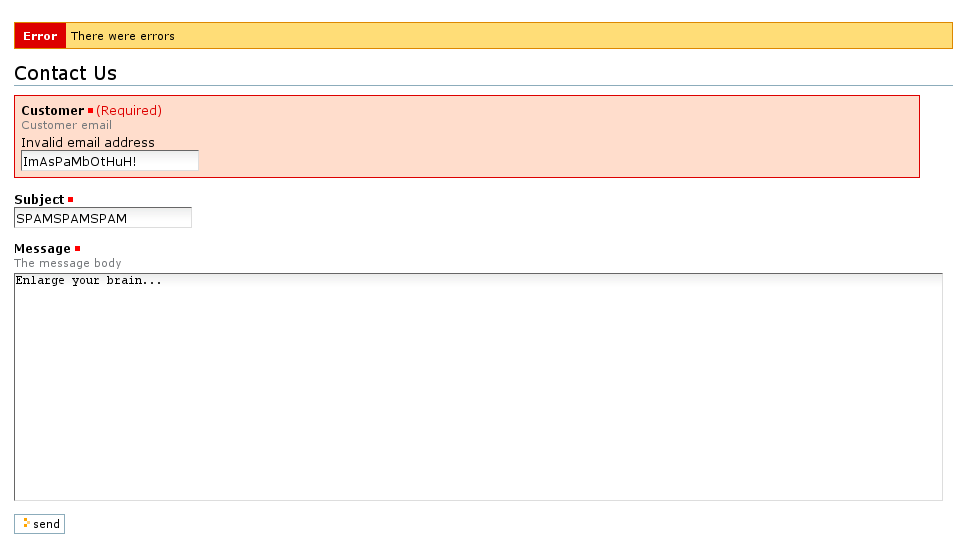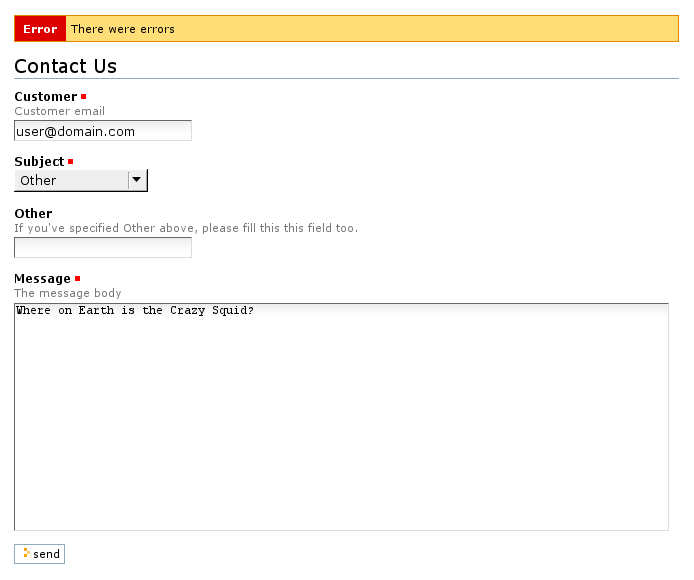Adding validation¶
Description
Server-side form validation is vital to ensure data sanity and protect our site from malicious users.
Field validation¶
Once you've understood the "hello form", let's move onto a more advanced topic: validation.
The easiest way to manage validation in a formlib-based form is to specify the validation rules in our schema. Actually, you've already implemented some validation: the customer, subject and message fields are required. If you leave the subject field empty, for example, and click the send button, a pretty red error message will show up asking you to fill that field.
Let's add email validation to the customer field
using the constraint keyword argument fot that attribute
in our schema. For simplicity, the mail address checker
that comes with the CMFDefault utilities toolbox will be
used in this example, althought you could also use your
own regular expression checking. The constraint argument
must be a callable that returns
True
if the value submitted is valid, or raise an exception
inheriting from
zope.schema.ValidationError, whose docstring will be used in the error message.
from zope.schema import ValidationError
class InvalidEmailAddress(ValidationError):
"Invalid email address"
from Products.CMFDefault.utils import checkEmailAddress
from Products.CMFDefault.exceptions import EmailAddressInvalid
def validateaddress(value):
try:
checkEmailAddress(value)
except EmailAddressInvalid:
raise InvalidEmailAddress(value)
return True
class IFeedbackForm(Interface):
"""
A typical feedback schema
"""
customer = TextLine(title=u'Customer',
description=u'Customer email',
required=True,
constraint=validateaddress)
subject = TextLine(title=u'Subject',
required=True)
message = Text(title=u'Message',
description=u'The message body',
required=True)
Now, if you type an invalid address into the customer field and click send, a kind and colorful error message will be displayed:

That was too easy, wasn't it?
Invariants validation¶
zope.formlib also supports the validation of schema invariants, e.g. the min value entered must be smaller than the max value. In this example the form will be extended to provide a set of predefined subjects and a field named other which must be filled when selecting the the Other option in the subject select dropdown. It's easier to explain it in Python than in English:
from zope.schema import Choice
from zope.interface import invariant, Invalid
class IFeedbackForm(Interface):
"""
A typical feedback schema
"""
customer = TextLine(title=u'Customer',
description=u'Customer email',
required=True,
constraint=validateaddress)
subject = Choice(title=u'Subject',
vocabulary='Available Subjects',
required=True,
)
other = TextLine(title=u'Other',
description=u"""
If you've specified Other above,
please fill this this field too.""",
required=False)
message = Text(title=u'Message',
description=u'The message body',
required=True)
@invariant
def otherFilledIfSelected(feedback):
if feedback.subject == u'Other' and not feedback.other:
raise Invalid("Please specify the motivation of your request")
Here, the subject field type has been set to Choice, and the list of available values has been indicated to be obtained from the Available Subjects vocabulary, a named utility which will be defined shortly.
The form will call all the invariant-decorated functions of the schema upon validation and catch any raised Invalid exceptions.
You still need to define the Available Subjects vocabulary:
from zope.schema.vocabulary import SimpleVocabulary
def availableSubjects(context):
subjects = ('Comment',
'Feature Request',
'Technical Issue',
'Complaint',
'Other',
)
return SimpleVocabulary.fromValues(subjects)
and register it as a named utility using ZCML in the
configure.zcml
file:
<configure ... >
...
<utility
component=".browser.availableSubjects"
name="Available Subjects"
provides="zope.schema.interfaces.IVocabularyFactory"
/>
</configure>
Restart your Zope instance for the changes to take effect and test your new form. You'll see something similar to this:

Unfortunately, invariant errors descriptions are not shown in the default template.
